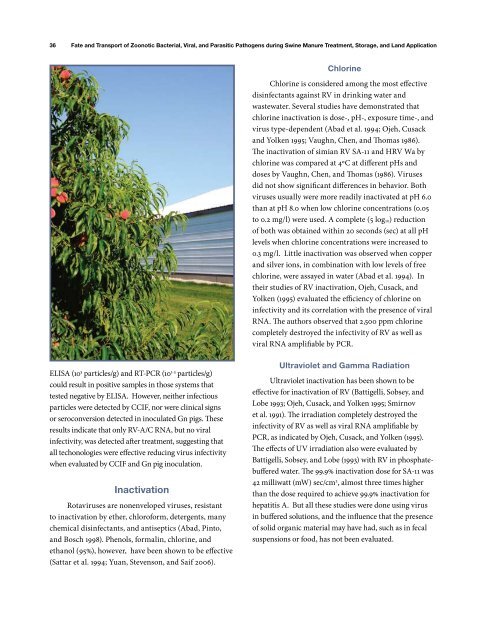Fate and Transport of Zoonotic Bacterial, Viral, and - The Pork Store ...
Fate and Transport of Zoonotic Bacterial, Viral, and - The Pork Store ...
Fate and Transport of Zoonotic Bacterial, Viral, and - The Pork Store ...
You also want an ePaper? Increase the reach of your titles
YUMPU automatically turns print PDFs into web optimized ePapers that Google loves.
36<br />
<strong>Fate</strong> <strong>and</strong> <strong>Transport</strong> <strong>of</strong> <strong>Zoonotic</strong> <strong>Bacterial</strong>, <strong>Viral</strong>, <strong>and</strong> Parasitic Pathogens during Swine Manure Treatment, Storage, <strong>and</strong> L<strong>and</strong> Application<br />
ELISA (10 5 particles/g) <strong>and</strong> RT-PCR (10 1-3 particles/g)<br />
could result in positive samples in those systems that<br />
tested negative by ELISA. However, neither infectious<br />
particles were detected by CCIF, nor were clinical signs<br />
or seroconversion detected in inoculated Gn pigs. <strong>The</strong>se<br />
results indicate that only RV-A/C RNA, but no viral<br />
infectivity, was detected after treatment, suggesting that<br />
all techonologies were effective reducing virus infectivity<br />
when evaluated by CCIF <strong>and</strong> Gn pig inoculation.<br />
Inactivation<br />
Rotaviruses are nonenveloped viruses, resistant<br />
to inactivation by ether, chlor<strong>of</strong>orm, detergents, many<br />
chemical disinfectants, <strong>and</strong> antiseptics (Abad, Pinto,<br />
<strong>and</strong> Bosch 1998). Phenols, formalin, chlorine, <strong>and</strong><br />
ethanol (95%), however, have been shown to be effective<br />
(Sattar et al. 1994; Yuan, Stevenson, <strong>and</strong> Saif 2006).<br />
Chlorine<br />
Chlorine is considered among the most effective<br />
disinfectants against RV in drinking water <strong>and</strong><br />
wastewater. Several studies have demonstrated that<br />
chlorine inactivation is dose-, pH-, exposure time-, <strong>and</strong><br />
virus type-dependent (Abad et al. 1994; Ojeh, Cusack<br />
<strong>and</strong> Yolken 1995; Vaughn, Chen, <strong>and</strong> Thomas 1986).<br />
<strong>The</strong> inactivation <strong>of</strong> simian RV SA-11 <strong>and</strong> HRV Wa by<br />
chlorine was compared at 4ºC at different pHs <strong>and</strong><br />
doses by Vaughn, Chen, <strong>and</strong> Thomas (1986). Viruses<br />
did not show significant differences in behavior. Both<br />
viruses usually were more readily inactivated at pH 6.0<br />
than at pH 8.0 when low chlorine concentrations (0.05<br />
to 0.2 mg/l) were used. A complete (5 log10) reduction<br />
<strong>of</strong> both was obtained within 20 seconds (sec) at all pH<br />
levels when chlorine concentrations were increased to<br />
0.3 mg/l. Little inactivation was observed when copper<br />
<strong>and</strong> silver ions, in combination with low levels <strong>of</strong> free<br />
chlorine, were assayed in water (Abad et al. 1994). In<br />
their studies <strong>of</strong> RV inactivation, Ojeh, Cusack, <strong>and</strong><br />
Yolken (1995) evaluated the efficiency <strong>of</strong> chlorine on<br />
infectivity <strong>and</strong> its correlation with the presence <strong>of</strong> viral<br />
RNA. <strong>The</strong> authors observed that 2,500 ppm chlorine<br />
completely destroyed the infectivity <strong>of</strong> RV as well as<br />
viral RNA amplifiable by PCR.<br />
ultraviolet <strong>and</strong> gamma radiation<br />
Ultraviolet inactivation has been shown to be<br />
effective for inactivation <strong>of</strong> RV (Battigelli, Sobsey, <strong>and</strong><br />
Lobe 1993; Ojeh, Cusack, <strong>and</strong> Yolken 1995; Smirnov<br />
et al. 1991). <strong>The</strong> irradiation completely destroyed the<br />
infectivity <strong>of</strong> RV as well as viral RNA amplifiable by<br />
PCR, as indicated by Ojeh, Cusack, <strong>and</strong> Yolken (1995).<br />
<strong>The</strong> effects <strong>of</strong> UV irradiation also were evaluated by<br />
Battigelli, Sobsey, <strong>and</strong> Lobe (1993) with RV in phosphatebuffered<br />
water. <strong>The</strong> 99.9% inactivation dose for SA-11 was<br />
42 milliwatt (mW) sec/cm 2 , almost three times higher<br />
than the dose required to achieve 99.9% inactivation for<br />
hepatitis A. But all these studies were done using virus<br />
in buffered solutions, <strong>and</strong> the influence that the presence<br />
<strong>of</strong> solid organic material may have had, such as in fecal<br />
suspensions or food, has not been evaluated.


